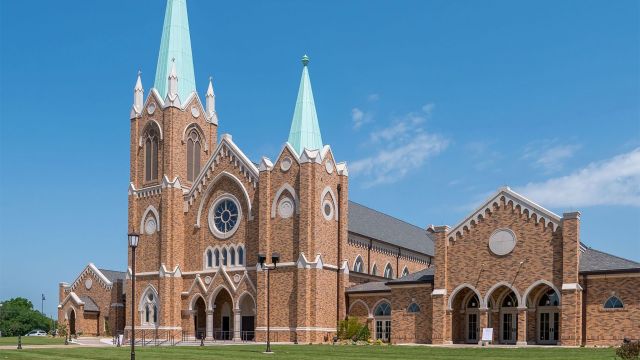St. Francis Xavier Catholic Church
Case Study
By Tim Michael
The St. Francis Xavier Catholic Church is new American Gothic Style church in the prairie landscape on the edge of the bustling college town of Stillwater, Okla. The architect for the church Franck & Lohsen Architects, designed color palate of the exterior brick veneer and precast limestone consistent with indigenous stone of the region that has a range of brown and red. A custom blend of five different brick colors is used for the exterior veneer.
The manufactured precast limestone was specified in the project for large size spires, detailed arches, window ornamentation, bandings, cornices, wall coping, architectural trim, etc. to achieve the desired end user experience and aesthetic appeal.
The church is crowned with a pair of towers and spires with the cross on the tallest spire reaching the height of 157’, making it visible for several miles.
The designers had developed detailed large size profiles with precise, intricate design details to give the building a level of ornamentation appropriate for an American Gothic church. The AAS team worked closely with the architect and contractor for the project early in the design phase to review CAD drawings and confirm design feasibility."
- Wet-pour architectural precast concrete for large size pieces
- Dry vibrant-tamp cast stone for majority of the detail pieces that could be molded on both sides for seamless integration with the exterior veneer
- Architectural GFRC (Glass Fiber Reinforced Concrete) for the cornices, coping at higher elevation
The AAS team developed custom molds using CNC technology. The stone cladding ornamentation with large stone pieces and intricate design details required extensive detailed mold work throughout the project. The large spires for the church weighed over 7,000 pounds.
The process to design and fabricate each stone piece included pre-engineered anchorage conditions to achieve the minimal design aesthetic of monolithic stone. Customer got detailed drawings to understand installation details for the stone pieces.
The manufacturing schedule for different phases of the project was lined up to synchronize with the construction milestones. The installation team got settings plan with detailed numbering system to identify specific placement location of every single stone piece delivered by AAS. Customer was able to track each stone piece individually using the RFID based tagging system of AAS.
The manufactured stone cladding highlights the exterior design of the church. The Advanced Architectural Stone (AAS) panels cost-effectively emulated the look and finish of the natural limestone.
About the Author
Tim Michael is Vice President of Operations for Advanced Architectural Stone.


















